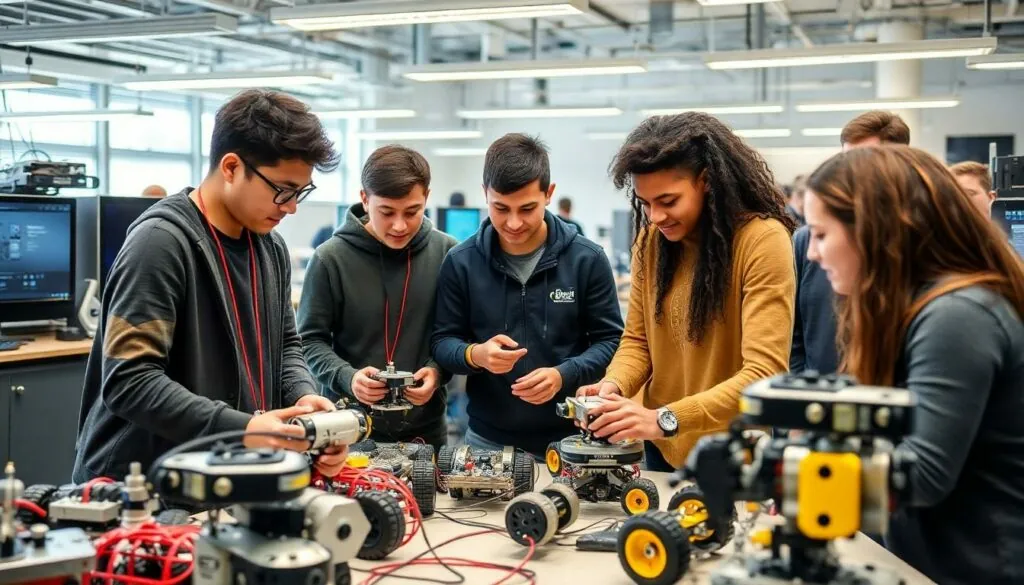In a world buzzing with tech jargon, two terms often steal the spotlight: virtual intelligence and artificial intelligence. But what’s the difference? Imagine virtual intelligence as the friendly barista who remembers your coffee order, while artificial intelligence is the genius scientist predicting your caffeine cravings before you even walk in.
As technology evolves, these two concepts are shaping the way we interact with machines. Virtual intelligence focuses on enhancing user experiences, making them smoother and more enjoyable. On the other hand, artificial intelligence dives deep into complex problem-solving, often making it the brainy counterpart.
Table of Contents
ToggleOverview of Virtual Intelligence and Artificial Intelligence
Virtual intelligence refers to systems designed to enhance user experiences through interactive features. These systems leverage historical data to provide personalized services. For instance, a virtual assistant can recall preferences, shaping its responses based on previous interactions.
Artificial intelligence encompasses a broader scope focused on learning and evolving beyond pre-programmed tasks. AI systems analyze vast amounts of data, allowing them to identify patterns and make predictions. For example, an AI model can assess user behavior to optimize product recommendations.
Both virtual intelligence and artificial intelligence contribute to human-machine interactions. Virtual intelligence prioritizes engagement and immediate support. In contrast, artificial intelligence emphasizes complex problem-solving capacities. Technologies like chatbots often utilize virtual intelligence to create seamless customer experiences.
Differences in functionality are notable. Virtual intelligence often involves narrower tasks, while artificial intelligence is equipped for more sophisticated applications. As businesses adopt these technologies, they begin to see shifts in efficiency and productivity.
Understanding the roles of virtual intelligence and artificial intelligence aids in selecting the right tools for specific needs. Companies benefit from utilizing virtual intelligence for customer service solutions and artificial intelligence for more intensive data-driven projects.
Their respective impacts on innovation and user satisfaction illustrate the diverse capabilities these technologies offer.
Key Differences Between Virtual Intelligence and Artificial Intelligence

Understanding the distinctions between virtual intelligence and artificial intelligence reveals their unique roles in technology. Each serves different needs within the broader landscape of human-machine interactions.
Definition and Scope
Virtual intelligence refers to systems aimed at enhancing user experiences through personalized interactions. These systems rely on historical data to adapt to user preferences. For instance, a virtual assistant recalls specific user queries over time, tailoring its responses accordingly. Artificial intelligence encompasses a wider scope, evolving through machine learning and data analysis. This technology can predict user behavior by identifying patterns within vast datasets. AI algorithms learn and adapt, tackling complex challenges beyond basic programming.
Functionality and Applications
Virtual intelligence typically handles narrower tasks. These applications focus on immediate user needs, such as responding to customer inquiries or providing recommendations based on prior interactions. For example, chatbots offering customer support effectively illustrate this functionality. In contrast, artificial intelligence addresses more sophisticated applications. AI systems analyze large volumes of data, which enables them to optimize processes and make strategic predictions, such as forecasting market trends. Businesses often integrate both technologies, using virtual intelligence for engagement and artificial intelligence for deeper analysis and problem-solving.
Benefits of Virtual Intelligence
Virtual intelligence offers distinct advantages that enhance user interactions and streamline functionalities. The following points outline key benefits that contribute to its growing importance.
User Experience Enhancement
User experience improves significantly through virtual intelligence. Customization of interactions is central, allowing systems to recall user preferences from previous engagements. Personalized recommendations arise from historical data, creating a smoother user journey. For instance, virtual assistants often suggest tailored content based on past choices, saving users time and effort. Immediate responses to inquiries lead to higher satisfaction levels. Engaging features enhance overall interaction, fostering a sense of connection between the user and technology. This user-centric approach positions virtual intelligence as a vital component in optimizing everyday tasks.
Accessibility and Usability
Accessibility greatly benefits from virtual intelligence. Adaptive interfaces cater to diverse user needs, ensuring inclusivity for various abilities. Intuitive designs facilitate effortless navigation, allowing users of all skill levels to engage with technology confidently. Virtual assistants frequently simplify complex processes, breaking information into manageable components. These enhancements promote usability across different platforms and devices. Improved accessibility aligns with the commitment to user-friendly technology, making it easier for individuals to access essential services. This focus on usability ensures that virtual intelligence appeals to a broad audience, contributing to its widespread adoption.
Benefits of Artificial Intelligence
Artificial intelligence (AI) offers numerous advantages that enhance various processes across industries. Organizations leverage its capabilities to improve efficiency and make better decisions.
Efficiency and Automation
AI significantly increases efficiency through automation. Businesses automate repetitive tasks that consume valuable time and resources. Employees focus on higher-value activities, resulting in enhanced productivity. Data processing speed and accuracy improve, minimizing human error. According to a report by McKinsey, organizations can boost productivity by 40% using AI-driven automation. Cost savings also arise from reduced operational expenses, allowing businesses to allocate resources more effectively. Automated systems can analyze vast amounts of data quickly, producing insights that inform strategic decisions.
Advanced Decision-Making
AI empowers advanced decision-making through data-driven analysis. By analyzing large datasets, AI systems identify patterns and trends that humans might overlook. This capability enables organizations to make informed predictions and optimize strategies. For example, AI algorithms forecast customer behavior, which helps in tailoring marketing efforts for maximum impact. A study by Gartner indicates that businesses utilizing AI for decision-making see a 25% increase in performance metrics. Machine learning models continuously learn and adapt, improving their accuracy over time.
Understanding the differences between virtual intelligence and artificial intelligence is crucial for businesses aiming to enhance their operations. Virtual intelligence excels in creating personalized user experiences through tailored interactions. It focuses on improving customer satisfaction and accessibility.
On the other hand, artificial intelligence tackles complex problems by analyzing vast datasets and optimizing processes. Its ability to automate tasks and enhance decision-making drives significant productivity gains.
By recognizing the unique strengths of each technology, organizations can strategically implement the right solutions to meet their specific needs. This knowledge not only fosters innovation but also enhances user satisfaction, ultimately leading to a more efficient and effective business landscape.






